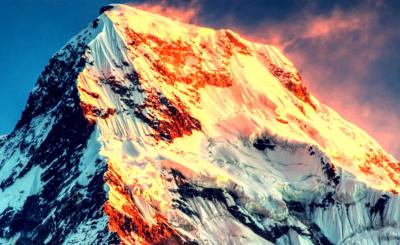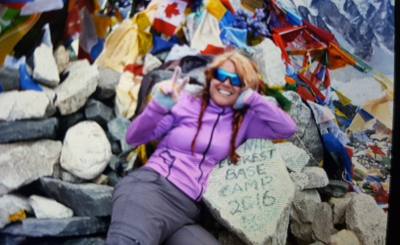Why Veg food is the Best Option on a High-Altitude Trek?
Nepal Trekking & Hiking in The Himalayas can be fun and exciting but is also a strenuous job. Depending on the length, maximum altitude, and terrain of a trek, it is usually advised for travelers to be in good physical shape. As you go higher up the Himalayas, risks of injuries are higher, and problems such as altitude sickness and acute mountain sickness are a common occurrence. Trekking Packages & Hiking in Nepal are surreal experiences but require adequate preparation and precautions to make them enjoyable. It is always good to know what you are getting into and how your body reacts during a trekking adventure. Travelers usually make sure that they have the proper equipment, guides, maps, layers, and first aid kits on treks, but one common thing that trekkers usually either overlook or are misinformed about is the optimal diet required on a trek. Especially when it comes to the consumption of non-veg food

High Altitude Digestion.
It is a very common practice for trekkers all over the world to focus on consumption of meat while on hikes. This is usually out of the necessity of the situation/location or to compensate for the extra protein that the body requires during the journey. But as one goes higher up the mountains, the difference in altitude causes the body to react differently to the food that is consumed. The high altitude causes the atmospheric pressure to drop, which causes the carbon dioxide dissolved in our bloodstream to be diffused outwards. This is due to the basic fact that molecules tend to flow from an area of higher pressure to an area of lower pressure. This diffusion of carbon dioxide leads to a person feeling bloated, which is commonly known as flatulence. In mountaineering science, the term for this phenomenon is HAFE (High Altitude Flatulence Expulsion). Our digestive system is not used to the high altitudes and naturally undergoes a level of high stress during this time. Meat is a great source of protein and sounds very tempting while on hikes because the body is exhausted as it burns an average of 7 calories per kg per hour during medium-level trekking. So, if you weigh 70 kgs, you burn a whole 490 calories per hour. But meat, which is already harder for our digestive system to dissolve and break down in normal conditions, becomes a nightmare for the body to process at higher altitudes. Just think of the times when you had an excess amount of meat and were just not able to move afterward due to flatulence and gas issues; the body is more susceptible to similar situations at higher altitudes. Furthermore, rapid and excess consumption of meat at higher altitudes can also cause severe loose motion. The mountains are not equipped with luxury bathrooms and you do not want to be in such a situation!
What Do You Eat on a High-Altitude Trek?
After all, it is suggested that a person carrying out medium-intensity exercise such as trekking should have the following nutrient profile:
- 45-65% carbohydrate (5-8 grams per kg per day),
- 10-35% protein (0.8-1 grams per kg per day) and
- 20-35% fat (0.5-1.5 grams per kg per day).
Trekkers should try to consume fresh food as much as possible. Canned and stored items should be avoided if possible. The rule of thumb for meals on treks is to make sure that your body gets an adequate amount of carbohydrates, as they are easily converted to energy, which is a constant requirement throughout. Mornings especially should be heavy on carbohydrates. Cornflakes is a good option for breakfast. During treks, you should avoid meat but should not totally disregard protein consumption. Soybeans and oats are considered the best sources of protein on treks. Their amounts need to be low, as it takes quite a while for them to break down. An ideal ratio of carbohydrate to protein during lunch and dinner is 3:1. Eggs are another great option during hikes if consumed moderately. They help to prevent sore muscles and replace muscle protein during treks. Travelers should always ensure that they are properly hydrated. It is recommended that hikers drink at least 5 liters of water per day to keep up with the strain that comes with Trekking & Hiking Destinations in Nepal. They should also carry highly nutritious food such as dry fruits, nuts, trail mix, and fruits with them. Chocolate and other sweet items should strictly be avoided. It is strictly recommended that alcohol be avoided during extreme treks, as it drains the body while causing dehydration. So, make sure you regulate the amount of protein you consume before and during a hike. Doing so will ensure that you will be able to enjoy the splendid beauty of the mountains without having to run to the bathroom frequently. Once you get back down to normal altitudes, you are free to feast like a beast!!
Recent Post
-

Trekking in Nepal
Trekking Package & Hiking in Nepal. -

The Massive Annapurna Himalayan Range
Trekking Package & Hiking in Nepal. -

Northeast Region of Nepal
Trekking Package & Hiking in Nepal. -

Everest Base camp Trek
Trekking Package & Hiking in Nepal. -

North and South of the Massive Annapurna Range in the Himalayan Mountains
Trekking Package & Hiking in Nepal. -

Why Veg food is the Best Option on a High-Altitude Trek?
Food Travelling -

Best Way to Explore Famous Peak in Himalayas
Trekking Package & Hiking in Nepal. -

Tour in Nepal
Holiday Tour Package in Nepal -

Nepal Trekking Package
Trekking Package & Hiking in Nepal. -

Annapurna Base Camp Trek: Route, Cost, and Key Essentials
Trekking Package & Hiking in Nepal.

